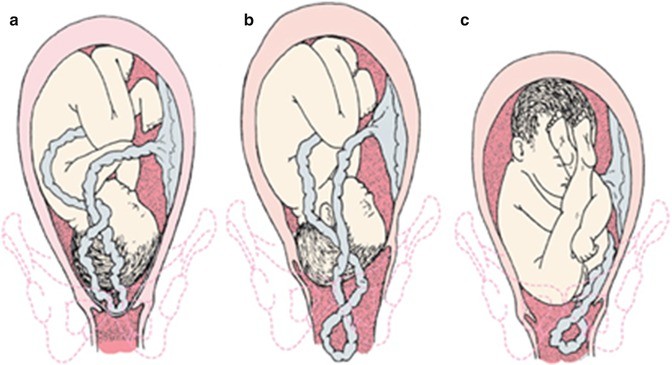During birth, the head of the baby is delivered first, which is then followed by the umbilical cord and placenta. But all births do not happen in the same order. Sometimes there can be situations in which the position of the baby is inverted, and the baby is not delivered first. Umbilical cord prolapse is one of these conditions which can put a baby in a lot of distress.
The given article describes the causes, risks, and treatment of cord prolapse.
What Is An Umbilical Cord Prolapse?
When an umbilical cord of the baby is pushed out of the cervix before the head of the baby it is known as umbilical cord prolapse. It is a complication that occurs before or during the delivery of the baby. Due to umbilical cord prolapse, the baby is pushed against the cord on the way out blocking the flow of oxygen and blood which leads to a critical condition for the baby. In this case, a baby is delivered quickly to prevent any mishap.
When the cord pushes out ahead of the baby it is overt umbilical cord prolapse and if the cord slides alongside the baby, then it is occult umbilical cord prolapse. Both of these can cause complications to the baby.
Causes
The causes of the prolapsed umbilical cord are as follows:
Premature rupture of the membranes (PROM): When there is an immature rupture of membranes or the membranes are artificially ruptured by the doctor, then the head of the baby is high in the uterus and the cord may go through the cervix first. The umbilical cord tends to get compressed when it is followed by the baby.
- Multiple deliveries: In case of multiple deliveries like in twins the baby that delivers first may push out the umbilical cord.
- Excessive amniotic fluid: In the case of polyhydramnios in which there is excessive amniotic fluid, the pressure of the fluid rushing out may push the umbilical cord out.
- Breech position: If the baby is in a breech position then the feet of the baby come out first which provides enough space to the umbilical cord to slide through the birth canal.
- The threat of prolapse is also high when there is a long umbilical cord.
- Premature delivery: In premature delivery the size of the fetus is small and the volume of amniotic fluid is more which allows the cord to slip out.
Symptoms
Signs of umbilical cord prolapse are as follows:
- Visible umbilical cord during the delivery.
- Due to a lack of oxygen, there is fetal distress.
- The decrease in the heart rate of the fetus for a long duration.
Risk Factors
Few of the risk factors of umbilical cord prolapse are:
- Artificial rupture of membranes by doctors
- Abnormal positioning of the baby
- Funic presentation in which the umbilical cord points towards the lower uterine segment or internal cervical opening
- Fetal anomalies
- Cord abnormalities if the cord is too long
- Fetal growth restrictions where the fetus is premature
- Polyhydramnios in which there is excessive amniotic fluid
- Amnioinfusion in which amniotic fluid is instilled into the amniotic sac to prevent deceleration of fetal heart rate
Risks of Cord Prolapse
The risks of cord prolapse are as follows:
Conditions like cerebral palsy develop because of a lack of oxygen supply to the brain.
- Abnormally slow heart rate and functioning.
- Tangled cord around the baby due to which there are complications during delivery that can be fatal.
Diagnosis
The methods which help to diagnose umbilical cord prolapse are as follows:
- A vaginal examination is done to diagnose the overt umbilical cord prolapse in which the cord is visible past the vagina during delivery. To minimize the handling of the cord, a doctor should avoid vaginal examination in clear-cut cases.
- Doppler ultrasound imaging is done to detect the fetal heart rate. Ultrasound may delay the delivery, posing a risk to the baby. C-section is performed if there is a deceleration in fetal heart rate. Pinard examination is also done to detect reduced fetal heart rate.
Treatment and Management
Umbilical cord prolapse is an obstetric emergency so a woman should firstly call for help. Following are how this can be managed:
- Avoid handling the cord: By doing this, vasospasm can be reduced.
- Elevate the presenting part: Elevate the presenting part of the cord by doing the vaginal examination. Alternatively, fill the maternal bladder with 500ml of normal saline by urinary catheter if available and arrange immediate hospital transfer.
- Encourage left lateral position: If a woman is put in the left lateral position, the pressure on the presenting part of the cord is relieved.
- Tocolytics: If immediate delivery is not possible then tocolytics should be used because they will relax the uterus, stop contractions and relieve pressure off the cord. This will give time to transfer a woman to a location where delivery is possible. If c-section is required in a case like fetal bradycardia then tocolytics are a good option.
- Delivery should be done through the cesarean section: In the case of prematurity where chances of maternal and fetal deaths are more, c-section is recommended.
- When there is cord compression due to low levels of amniotic fluid, an amnioinfusion should be conducted.
Prevention
To lower the risk of cord prolapse following factors need to be avoided:
Avoid accidental or intentional rupturing of the membranes.
- If induction of labor is needed then first consult to the doctor or choose cesarean delivery, which is one of the safe options.
- In the case of polyhydramnios, prepare in advance for any risks during delivery.
- If timely interventions do not take place then umbilical cord prolapse could be dangerous for the baby. So, before delivery, a woman should first consult her doctor in advance.
Conclusion
When the umbilical cord descends below the cervix and is alongside or below the presenting part of the fetus, then it is said to be a prolapsed umbilical cord. It is an obstetrical emergency in which the fetal mortality rate is 91 per 1000. The diagnosis should be suspected in any patient and the first step is to call for help. This can be managed by elevating the presenting part and deliver via the quickest method.
Sources:













